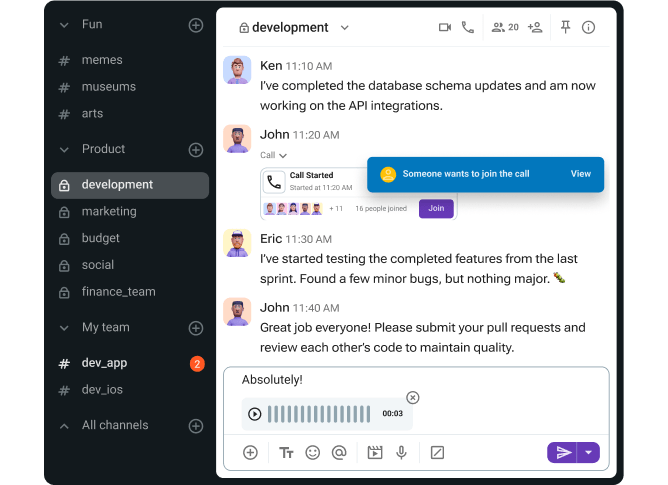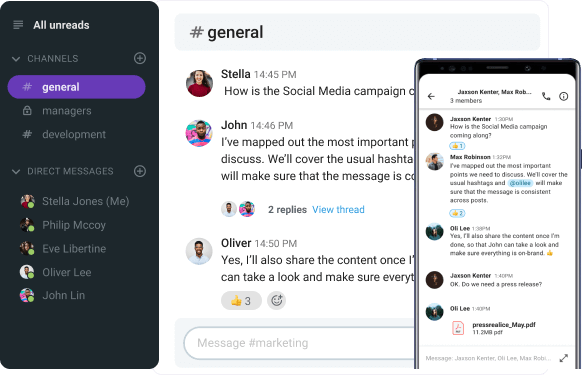Imagine one of your best employees is 30 years old and they’ve been working in your company ever since they graduated. They seem to like it there — they get along with everyone, they are okay with the office hours, and they even get to leave early from time to time.
However, recently, it seems they’ve lost their enthusiasm, almost as if they’re having second thoughts about working in the company.
What if we told you that this feeling is quite natural? In fact, studies show that nearly 50% of employees want to quit their jobs for various reasons.
But, at the end of the day, most reasons boil down to one common denominator — your company did not do its job when it comes to keeping employees motivated and eager to stay.
So, we’ve done our best to research and collect the best employee retention strategies to help employers reduce turnover rates and keep their companies afloat.
In this post, we will:
- Explain the concept of employee retention strategies,
- Discuss the importance of employee retention,
- Dig into the reasons behind employee turnover, and
- Present valuable employee retention strategies.
Let’s go!

Table of Contents
What is employee retention?
You’ve probably heard the phrase “employee retention” before, so you already have a general idea of what it means. However, there are some nuances worth discussing when it comes to this concept.
For starters, employee retention is generally defined as the organization’s capability to motivate and keep employees from leaving. In other words, it represents a set of strategies, mottos, and regulations that exist within the organization with the goal of preventing turnover.
However, with a constant supply of fresh graduates and eager young people who enter the workforce every year, a question comes to mind — “Why bother with employee retention when there will never be a shortage of young workers?”
Or, simply put, why is employee retention so important?
The importance of employee retention
Companies have to keep up with the ever-evolving times and the quick pace of progress, so it makes absolute sense to hire younger employees who grew up in the modern world.
However, this doesn’t necessarily mean you should restructure teams every few years and constantly bring in new people. Keeping experienced individuals on board often proves to be beneficial in the long run for many reasons.
For example, training and development of new hires take time and company resources. And, after all is said and done, you still don’t know if the new employee will fit the team structure and prove to be a good hire.
Additionally, when an employee leaves the company, a sense of disturbance and instability ensues, as other employees feel unsafe regarding their future in the company.
It’s also important to mention that when an old employee leaves, their tasks don’t leave with them. In other words, depending on the task at hand, it could take a significant amount of time to regain control of the project and fill the hole left by the old employee.
These are just some of the many reasons why a company should invest in its employees. Still, turnover rates don’t seem to be decreasing, which is why we have to ask ourselves another question — “Why are employees leaving?”
💡 Pumble Pro Tip
Keeping everyone happy and satisfied might seem like an impossible task. Well, fret not, we’ve found some expert tips that will shed some light on the topic.
Why are employees leaving?
The end of 2024 saw yet another increase in quit rates in the US and such a trend is not a novelty in the States. The COVID-19 era saw the largest quitting trend in recent years and things have not quite stabilized since.
But why?
Well, we can track the data and make elaborate conclusions, but there are simply too many reasons to choose from. However, we can find the most common denominators and go from there.
For example, a Harvard Business Review study found the 4 main reasons employees leave their jobs:
- Feeling stuck,
- Wanting a hard reset,
- Seeking more lucrative opportunities, and
- Taking the next professional step.
These findings are logical and probably contain some of the reasons that might have led you to leave some previous places of employment. However, it’s worth noting that, with the right guidance and strategy, these reasons can become obsolete.
Implementing employee retention strategies can greatly reduce turnover rates by putting the effort to resolve these issues in-house.
For example, encouraging employees to transparently share their frustrations, such as feelings of hopelessness and lack of direction, can help their superiors make their workday more inspiring.
Or, if an employee is seeking to make the next professional step in their career, offering in-house training for a new position could be the key to retaining them.
So, how exactly would one do it?
💡 Pumble Pro Tip
One of the reasons employees choose to stay and not jump ship is due to a positive work environment. Having fun with their colleagues and leaving the office with a smile on their faces is what keeps them motivated and engaged. Still, such a culture doesn’t happen on its own, so check out the following blog to learn how to build one:
Top 10 employee retention strategies
Naturally, a company or an organization will always find ways to either award or disappoint their employees. It’s the simple truth of business — sometimes the market is good and employees are content and sometimes, well, things go sideways.
However, during rough times, managers and leaders must step up and ensure every single employee feels valued, appreciated, and motivated to stay on board.
So, without further ado, here are the top 10 employee retention tips you can implement and get people to stay.
Strategy #1: Find the right people for the job
Simply put, you cannot retain people who weren’t willing to stick around in the first place.
Attracting the right type of people isn’t simply about finding the ones who know the job inside out. It’s about finding people who are:
- The right cultural fits,
- Looking for a long-term commitment, and
- Passionate about their work.
Finding them is not easy, which is why the HR department’s work needs to be spot on.
First off, constructing a psychological profile of the entire team would help you get an idea of what type of candidate would be a good fit. Also, paying attention to each resume and reviewing them on a daily basis can help you select the right candidate in the long run. Finally, in order to make sure you found “the one”, conduct multiple HR interview rounds to get to know the candidate more thoroughly.
Strategy #2: Improve employee engagement
If you see a decrease in employee performance and engagement, chances are you’ll be losing employees by the end of the current quarter. If that’s not motivating enough, think about the resources and profits that will be lost due to poor work and low productivity. A study by Willis Towers Watson found that organizations with employees eager to work achieved profits 5 times higher than the companies with disengaged workers.
In most cases, lack of engagement stems from harboring negative feelings toward the workplace and the issues that occur on an everyday basis.
One way to improve employee engagement is by letting the employees vent their frustrations and concerns by scheduling regular meetings. Make sure they are heard and ensure them you’ll be working on improving important issues that keep them disengaged from work.
Aside from live meetings, you can schedule video chats with your employees using communication apps, such as Pumble. If one of your employees is not using the app, you can send them a link to the meeting, which they can access via web and join you externally.
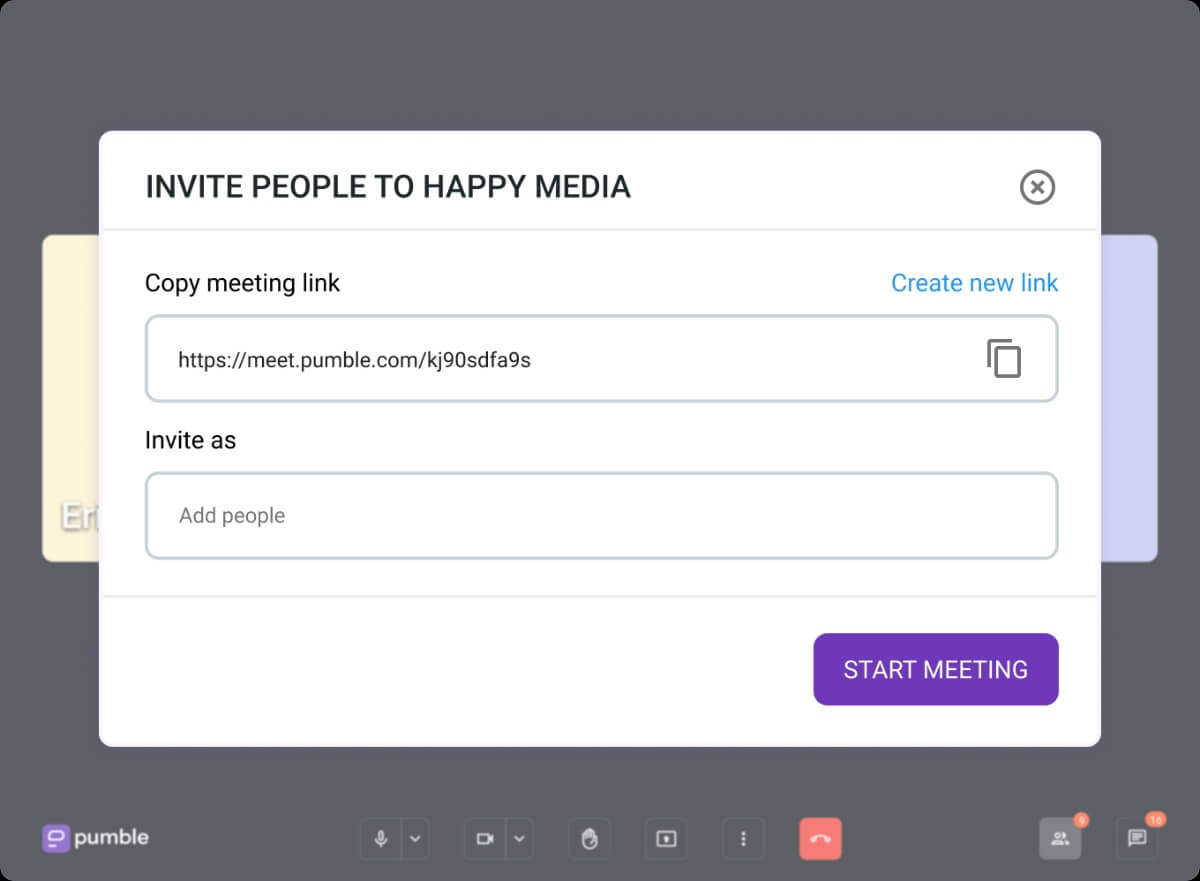
Streamline communication with Pumble
💡 Pumble Pro Tip
For additional tips on how to improve employee engagement at work, check out the post below:
Strategy #3: Reward hard work
This one is a no-brainer — if hard work is not rewarded and recognized, employees will feel disgruntled and unwilling to cooperate, which will ultimately lead to their departure.
However, this is a delicate situation that usually can’t be easily resolved.
On the one hand, if you start awarding everyone who works hard and the business doesn’t generate enough profits, you’ll be losing money. On the other hand, if you award no one, your employees will be dissatisfied, which can lead to their departure — again, losing your business money.
Therefore, try to find a compromise that works for everyone. Work together with the finance team to figure out the best way to offer financial incentives and bonuses. If money is tight, you can improve employee experience by introducing additional perks, such as:
- Extra time off,
- Coupons and gift cards, and
- Remote work options.
Strategy #4: Offer work-life balance
Putting work-life balance first is a powerful strategy for reducing turnover. According to a study published in Forbes magazine, 36% of questioned managers reported numerous cases of employee burnout, with the numbers reaching an alarming 60%.
Most companies that don’t prioritize work-life balance end up with plenty of exit interviews that feature burnout stories.
Additionally, businesses that focus on the employee as an individual see a massive increase in:
- Loyalty,
- Overall job satisfaction, and
- Increased performance.
Some helpful tips to improve your employees’ work-life balance would be to:
- Encourage breaks,
- Set realistic goals and deadlines, and
- Provide continuous support.
If your workers feel appreciated and seen, they’ll be more likely to return the favor and put in the extra effort during their work hours.
Strategy #5: Nurture your company culture
Every organization, no matter the size, develops its own identity and culture. However, it’s up to you to shape it and make it a positive one.
If you set clear goals and realistic expectations for your employees without any pressure, you’ll quickly realize they’ve started to share your vision with you.
Once you have that covered, it’s time to focus on fostering healthy team communication. Oftentimes, employees are worried about speaking out and voicing their concerns. Encourage open communication by being transparent and honest.
Finally, implement team-building activities to foster a sense of belonging among employees and truly develop a successful and positive workplace culture.
💡 Pumble Pro Tip
Organizing team-building activities is just one of the many ways you can improve your company culture. To learn more about it, check out the post below:
Strategy #6: Introduce professional development training
It’s quite common for employees to feel stuck, especially if they’ve been working at the same place for a while. That’s especially true if the job is monotonous and has low potential for creative growth.
In such cases, it’s only natural they slowly drift away and explore other avenues.
Solution?
Start by asking employees to fill out polls and forms related to their future expectations and interests. From there on, find creative ways to help every employee grow.
You can do this by hiring external parties to conduct training sessions or have HR and other professionals in the field create workshops and presentations.
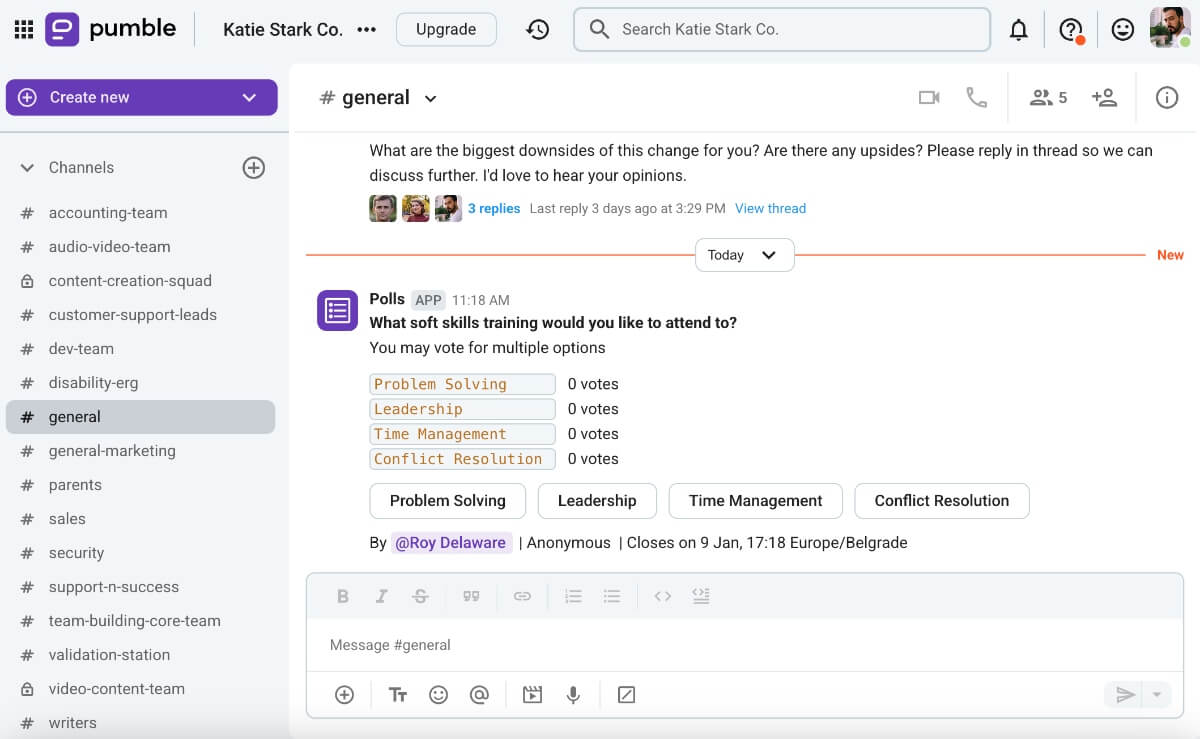
Foster healthy team communication with Pumble
Strategy #7: Make mental health awareness a priority
Unfortunately, the modern business era is very well known for the rise of mental health issues. With the increase of remote work and the stress that comes with everyday challenges, more and more people struggle with work-related mental health issues.
But, even though problems are on the rise, dealing with them isn’t — a lot of people hide their problems or refuse to candidly speak about them due to social stigma. This affects not only individuals but also companies, as neglected mental health can lead to a lack of motivation and productivity in the workplace.
Don’t make that the case at your company — encourage people to seek help and offer continuous support along the way.
One way to do it would be to have HR conduct regular, confidential 1:1 meetings with employees. Also, expanding sick leave to include mental health leave should be your number one priority as a way to help employees and consequently reduce turnover rates.
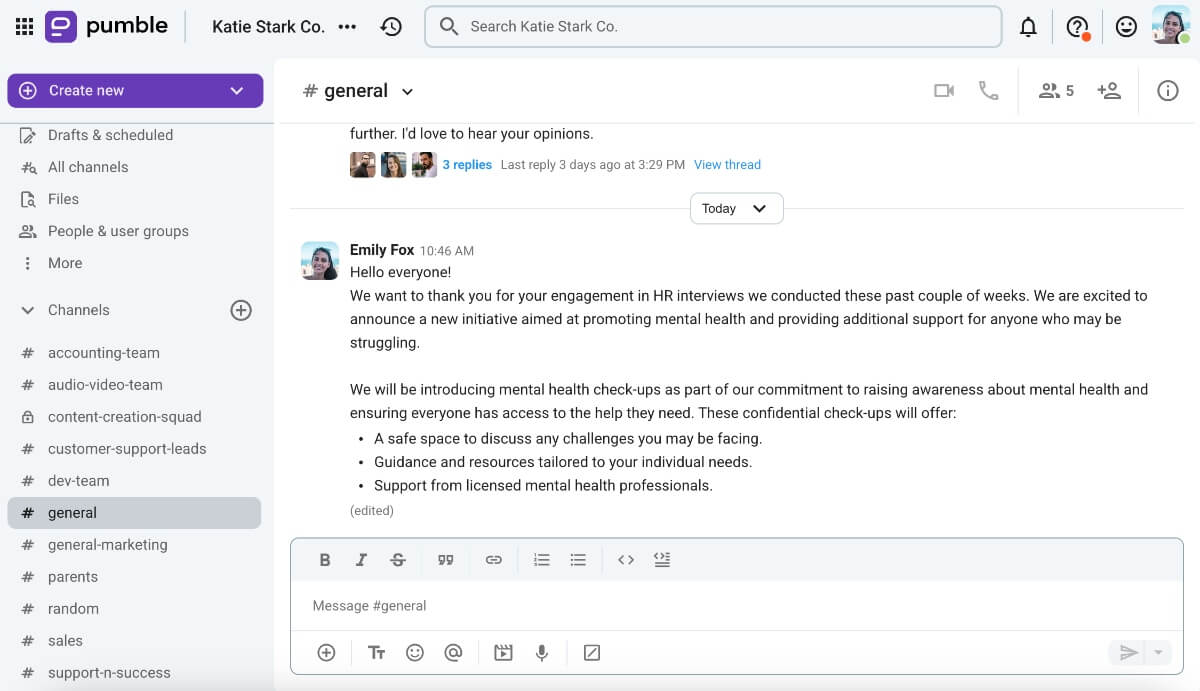
Never miss an announcement with Pumble
Strategy #8: Provide career development opportunities
Having an honest, hard-working employee do the same job for years can be problematic.
On the one hand, they are quite experienced and that’s something you need for the position they fill. On the other hand, they probably feel like they can do more and want a bump on the corporate ladder.
Still, you have to give everyone a chance to grow. Otherwise, they’ll feel disgruntled and underappreciated and start looking for other career opportunities.
Therefore, the solution is simple — design a leveling framework centered around offering employees opportunities for personal growth and lateral moves within the company.
Strategy #9: Introduce collaborative leadership
Some businesses can greatly benefit from a collaborative-style structure where everyone is held accountable and the team dynamics rests upon mutual empowerment.
Such an atmosphere ensures everyone feels comfortable and no hard feelings are harbored. In other words, it helps boost employee morale and experience, and consequently, retention.
There are many simple things you can do to introduce a collaborative-style structure in your company, such as:
- Clearly state and define your company mission.
- Schedule activities and team-building exercises that build trust.
- Encourage your team to share ideas.
- Invest in collaboration tools.
💡 Pumble Pro Tip
A collaborative leadership environment might sound like a fairytale, but it does exist. All it takes is dedication and the right mindset to achieve it. Learn more about it in the following blog:
Strategy #10: Make sure everyone feels accepted
Unfortunately, discrimination still exists in the modern workspace and is one of the leading reasons employees feel dissatisfied in an organization. Whether it’s due to ethnicity, age, or religious beliefs, reports on workplace discrimination skyrocketed in 2024 with the US Equal Employment Opportunity Commission receiving over 500,000 calls.
As the leader of your company, do your part. Here are some tips on how to start:
- Institute zero-tolerance discrimination policies that clearly prohibit any unlawful discrimination practices.
- Train your staff and use this opportunity to celebrate diversity.
- Gather your employees and celebrate all the major holidays and events.
💡 Pumble Pro Tip
Sadly, not many people are educated on proper practices and policies when it comes to discrimination. Celebrating diversity can only lead to higher engagement and better business results. Share the following blog with your organization to learn more about diversity in the workplace:
Build a strong and cohesive workforce through transparent communication: Try Pumble
It goes without saying that communication is key in all aspects of business, including employee retention. The modern office is based around remote work, which is why continuous communication is more important than ever.
So, if you’re looking for an accessible way for an employee to voice their concerns and fears, Pumble has all the features you’ll ever need, and more.
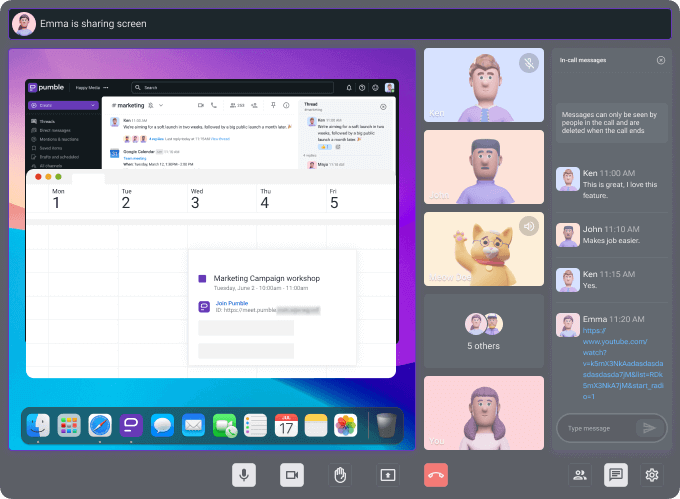
Let’s say an employee wants a quick chat to discuss their status in the company. They’ve sent you a direct message, but you have some good news that you want to share in a more personal way.
Invite them to a video conference call and let them know their hard work has paid off and they’re getting a bonus.
Or, let’s say you’ve created an outline that states the necessary steps for an employee to move up in the company hierarchy. Use Pumble’s file-sharing feature to deliver the outline to everyone instantaneously.
Make sure everyone is heard with Pumble — try it for free today!

